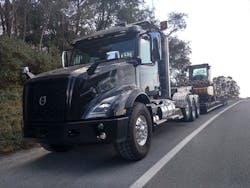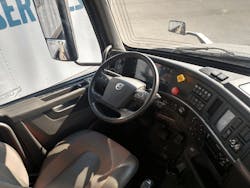How Does the Next-Gen Volvo VNX Truck Drive?
Comfort is a requirement for heavy trucks of all applications these days, at least if their owners want to keep them staffed. Few men or women are willing to drive bare-bones machines anymore, so quietness, decent ride quality, and pleasant surroundings have become standard equipment. On those counts, no one scores higher than Volvo Trucks, which is known among drivers for the cushiness it builds into its VNL highway tractors. That’s also true for Volvo’s vocational model, the VHD, and now this truck, the Volvo VNX heavy haul tractor, which combines on- and off-highway features.
Volvo builds the VNX for carriers of construction equipment, machinery, bulk commodities, logs, and other high-weight cargoes. The second-generation version has blacked-out front-end treatment and a redesigned interior shared with other Volvos. It’s standard with Volvo’s own D13 diesel, and Cummins X15 Performance Series engines are optional. Both can be mated to automated or manual transmissions and chassis specifications set up for individual customers. The X15 replaces the Volvo D16 diesel that was discontinued in January 2017 for lack of sales, causing a temporary withdrawal of the first generation VNX that came only with the D16.
VNX is an extra heavy-duty version of Volvo’s VNR regional tractor. Though it has high ground clearance so it can venture off road, it is primarily a highway hauler. It’s rated for gross combination weights of 125,000 to 160,000 pounds, and up to 225,000 pounds with proper components and approval by factory engineers. Heavy-haul is a small segment of the Class 8 market, but Volvo wants to be in it so its customers need not go elsewhere for such vehicles, according to company executives.
Volvo VNX-300 Test Set
This VNX-300 daycab was made available for a test drive at an event this past fall at Volvo’s Customer Center adjacent to the New River Valley assembly plant in Dublin, Virginia. It wore its stealthy styling, with metallic black paint contrasted by chrome-covered mirror heads and polished aluminum wheels, fenders, and cab guard. The tractor was hitched to a long lowboy semitrailer carrying a Volvo compactor. The rig looked heavier than it was, for a scale ticket put its gross combination weight at 75,540 pounds. Thus the tractor’s pusher-type lift axle and the trailer’s third axle, necessary to legally support burlier machinery, remained raised. The lowboy’s 53-foot length proved a bit of a challenge while making an acute-angle left-hand turn from the top of an off-ramp onto a secondary road. I took the corner as wide as I could and watched in the mirror as the trailer’s left-side wheels almost kissed a guardrail at the edge of the pavement. An inspection a few minutes later showed no scratches, so evidently I cleared it. The tractor’s steer axle allowed a fairly tight wheel cut, even with wide 425-series tires, which helped in the maneuver.
This was along Interstate 81, which Chris Stadler, a Volvo sales and market manager, had suggested as the most expedient way to accumulate some miles. I-81 skirts the southern edge of Dublin and is about a mile and a half from the factory via Cougar Road, a modern semi-rural highway. It’s a good route on which to familiarize one’s self with a tractor-trailer, for it includes gentle curves and one tighter bend as it progresses downhill toward a strip mall shopping area. All Volvos have spacious cabs, and my first impression is always that it’s too wide for a travel lane, but of course it’s not. A traffic light-controlled right turn onto four-lane State Route 11 required using all available lane space to avoid dragging the trailer’s right-side wheels beyond the pavement’s edge.
For this and throughout the run I needed only to mind where the rig was, because the VNX had a 14-speed version of Volvo’s smooth-operating I-shift automated manual transmission that did all the gear changing. It ably chose which ratios to use and, although it allows a driver to control things if he wishes, the software in its electronic “brain” seemed to know exactly what to do in every circumstance. While accelerating, it skip-shifts often—passing over one or two ratios, especially at low road speeds—and downshifts as needed on highway upgrades. A standard I-Shift is a 12-speed, and 13- and 14-speed variants employ an extra gearbox to provide low-low ratios for good startability on upgrades with heavy loads. A huge majority of Volvo highway trucks now go out the factory door with I-Shifts, and once they have driven one for a few days and see how well it works and how much work it relieves them from, even skilled gear jammers become converts to the idea of transmission automation.
Under the sloping hood was a Volvo D13 diesel, set for its top rating of 500 horsepower and 1,850 lb.-ft. of torque. A 455/1,750 rating is also available. It was more than enough for the rig’s moderate (in heavy-haul terms) overall weight, and it pulled upgrades nicely, usually staying at revs below 1,500, and cruised without exerting itself. In the VNX, the bigger Cummins X15 Performance series diesel comes with ratings of 565 or 605 horsepower and 1,850 and 2,050 lb.-ft., respectively. The Cummins is available with multispeed Eaton Fuller Ultra Shift Plus AMTs, and either engine series can also be had with Eaton 13- and 18-speed manual transmissions.
As with other Volvos, the VNX was a pleasure to drive. This daycab was roomy both laterally and front-to-back. The ride was smooth, the cabin quiet, and outward visibility excellent. The roomy daycab is plenty wide and long enough to accommodate long-legged guys, and the seat and multi-adjustable steering column and wheel can be set for drivers of all sizes. If overnight runs are in a VNX’s future, it is also available in two sleeper-cab versions, the VNX-400 with a 42-inch cab extension and the 740 with a 70-inch-long sleeper area, the latter suitable for longer hauls and frequent sleepovers. Numerous grab handles and well-designed steps make entry and exit easy and safe, and for 2020 Volvo makes active safety devices, including adaptive cruise control with braking assist, standard. Like other Volvos, the VNX is a posh conveyance, whether on smooth pavement or rough roads. It seemed to me that most anyone except, perhaps, diehard devotees of other makes would enjoy driving one.

